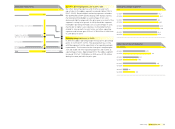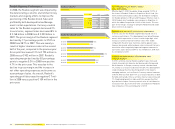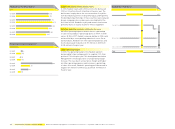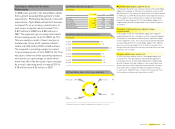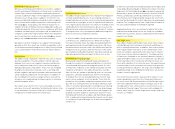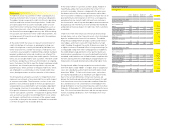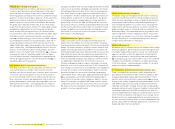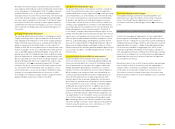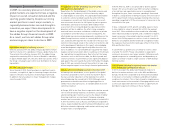Reebok 2008 Annual Report Download - page 115
Download and view the complete annual report
Please find page 115 of the 2008 Reebok annual report below. You can navigate through the pages in the report by either clicking on the pages listed below, or by using the keyword search tool below to find specific information within the annual report.
adidas Group Annual Report 2008 111
Social and environmental risks
We have a continuing responsibility to our workers, suppliers
and the environment. Malpractice in these areas, in particular
human rights violations and dubious employment practices,
can have a signifi cant impact on the reputation and operational
effi ciency of our Group and our suppliers. To limit this risk,
we have established workplace standards to which suppliers
must conform before and during business relationships with
the Group see Sustainability, p. 067. Internal inspections of
supplier factories verifi ed by extensive independent audits are
conducted regularly. In the event of non-compliance with these
standards, we develop joint action plans and set deadlines for
compliance and further improvement. When these deadlines
are not met, business relations are terminated see Sustain-
ability, p. 067, and www. adidas-Group.com /sustainability.
We expect to further strengthen our supplier monitoring pro-
gramme in 2009. As a result, we continue to regard the risk of
social and environmental malpractice as likely in only isolated
cases and we believe the potential fi nancial impact remains
low.
Natural risks
The adidas Group is exposed to external risks such as natural
disasters, epidemics, fi re and accidents. Further, physical
damage to our own or our suppliers’ premises, production
units, warehouses and stock in transit can lead to property
damage and business interruption. These risks are mitigated
by ample loss prevention measures such as working with
reliable suppliers and logistics providers who guarantee high
safety standards and disaster recovery plans. In addition to
the considerable insurance coverage we have secured, the
Group has also implemented contingency plans to minimise
potential negative effects.
Our overall assessment of this risk is unchanged versus the
prior year. As a result, we believe the likelihood of natural risks
is low and expect only minor fi nancial loss after insurance
compensation should natural risks materialise.
Strategic and Operational Risks
Portfolio integration risks
The adidas Group is exposed to risks related to the integration
of newly acquired businesses. In our ongoing initiatives to
integrate businesses, we face a risk of overestimating potential
revenue and cost synergies as well as organisational execution
risks. Organisational execution risks relate, for example, to the
standardisation of functional business processes across the
different brands and harmonisation of the Group’s IT systems.
To mitigate these risks, we implement dedicated integration
teams to oversee our integration activities.
In 2008, the adidas Group acquired several companies, such
as Textronics, Inc. and Ashworth, Inc. While these integra-
tions were relatively small, the adidas Group benefi ted from
past experience and strong integration processes. We there-
fore believe there continues to be a low likelihood of portfolio
integration risk occurrence. And now that most of the syner-
gies related to the Reebok integration have been realised, we
regard the potential fi nancial impact of these risks as low.
Risks from loss of brand image
Maintaining and enhancing brand image and reputation
through the creation of strong brand identities is crucial for
sustaining and driving revenue and profi t growth. It is also
an important credential as we extend our brands into new
categories and regions. The adidas Group faces consider-
able risk if we are unable to uphold high levels of consumer
awareness, affi liation and purchase intent for our brands.
To mitigate this risk, we have defi ned clear mission state-
ments, values and goals for all our brands. These form the
foundation of our product and brand communication strate-
gies. We also continually refi ne our product offering to meet
shifts in consumer demand and to contemporise our offering
to respond to current trends. Central to all our brand image
initiatives is ensuring clear and consistent messaging to our
targeted consumer audience, in particular at point-of-sale.
Strong brand momentum at adidas and TaylorMade-adidas
Golf, as evidenced in improving market research results, gives
us confi dence that brand image risk in both these segments
remains low.
In 2008, we launched several Reebok product technologies and
a new global brand campaign to improve the overall consumer
experience for the Reebok brand
see Reebok Strategy, p. 052.
Nevertheless, given the diffi cult economic situation in North
America and Europe, and the possibility that our revitalisa-
tion initiatives fail to improve brand image in the short term,
we view the likelihood of a further reduction in brand image as
medium. This could potentially have a high fi nancial impact on
the sales and profi tability of the Reebok segment.
Aggregating these risks, we continue to believe that in the
medium term brand image risk for the Group has a medium
likelihood of occurrence and also a medium potential fi nancial
impact on our Group.
Own-retail risks
New adidas, Reebok and Rockport own-retail stores require
considerable up-front investment in furniture and fi ttings as
well as ongoing maintenance. In addition, own-retail activities
often require longer-term lease or rent commitments. Own
retail also employs signifi cantly more personnel in relation
to net sales than our wholesale business. The higher portion
of fi xed costs compared to our wholesale business implies a
larger profi tability impact in cases of signifi cant sales declines.
The Group reduces this risk by only entering into lease con-
tracts with a duration of less than ten years. Store performance
is measured by a retail scorecard consisting of nine quantita-
tive key performance indicators. All shops are ranked by their
weighted average score. Underperforming stores are restruc-
tured or closed as appropriate.
The current macroeconomic situation and its impact on con-
sumer spending increase the risk of lower performance of
our retail stores. We therefore believe the likelihood of major
own-retail underperformance remains medium. Due to the
strong growth of own-retail activities, we continue to assess
the potential fi nancial impact from own-retail underperfor-
mance, which may also involve impairment charges and store
closures, as medium.


